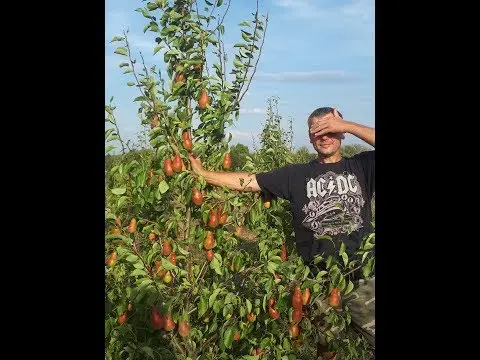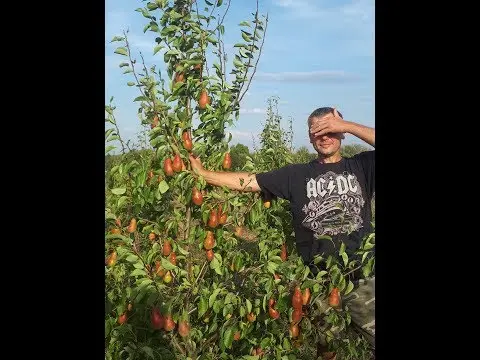Contents
Often gardeners prefer to grow dwarf pears, they are easier to care for, easier to harvest. Low trees are better illuminated by the sun, they enter the fruiting period earlier. But finding a seedling of a dwarf pear of a variety you like is problematic. The solution is to graft the pear onto the quince. This method has long been used to grow pears in the south, but the emergence of modern hardy quince varieties that can become a good rootstock is pushing this breeding method further north.
Features of vaccination
Grafting is a common method of propagating fruit crops to preserve the qualities of mother plants. When growing pears, quite often several different varieties are grafted onto one tree; as a rule, a wild pear serves as a stock. Pears are grafted onto hawthorn, quince, mountain ash, each graft has its own advantages and disadvantages. Pears grafted on quince grow actively only before the start of fruiting, then they sharply slow down growth, and fruits begin to bear in the third or fourth year. If the rootstock is a wild pear, then fruiting does not begin until the sixth year, and active growth continues for several more years after it begins.
Dwarf trees with quince as a rootstock do not give root offspring, and there are no tops on the trunk below the graft. The fruits increase by a third, their taste is also improved. But they require certain conditions for good growth and a bountiful harvest. So, the soil should be heavy enough to retain moisture and contain many nutrients, humus-rich loams are best suited. On light sandy soils, such trees will not give a good harvest, and they will not live long.
The quince root system is located close to the surface, it needs a lot of moisture, periods of drought will have a bad effect on the fruits.
If there is a lack of water at the beginning of summer, then the growth of shoots will slow down, leaves and ovaries may fall off, a lack of moisture in the second half of summer will affect the size and keeping quality of fruits.
You need to know that such a stock makes the pear less winter-hardy, at temperatures below -20 degrees it is better to cover the trees. For the winter, it is imperative to mulch the trunk circle (up to one and a half meters around the trunk) with peat, sawdust, compost, straw to a height of at least 10 cm, then make sure that a thick layer of snow has settled on top.
The surface root system does not provide much stability, so for the first few years the tree should be tied to a deeply driven peg so that a strong wind does not damage it.
Video “Pear Orchard”
From the video you will learn how it looks and how to care for such a garden.
The main methods of vaccination
Vaccination is most often done in the spring before the start of sap flow, some experienced gardeners do it in the summer, but survival is best after spring vaccination. The most common method is budding with a cutting, it can be simple and improved, it is resorted to if the thickness of the scion and rootstock is the same. If the scion is much thinner than the rootstock, then a split is used.
For simple budding, on the branches of the stock and scion, an oblique cut is made from the side opposite the bud. It should be very even and the same on both branches so that they can fit perfectly. Moreover, the bark and cambium must coincide, along which the movement of juices is carried out, which means that the branches are fed. You need to work only with a very sharp and disinfected tool. The scion branch should contain two well-developed fully formed buds in addition to the one opposite which the cut was made. The branches are combined and wrapped very tightly with electrical tape, by the way, there is a special grafting tape for winding, which does not stick to the tree, but simply wraps tightly and ties, its main advantage is slow destruction under the influence of sunlight.
Those buds that are opposite the cuts are wrapped with tape, and the next two buds of the grafted cutting should grow. The cut above these buds must be covered with garden pitch. If there are shoots on the rootstock below the grafting point, they need to be cut. It is desirable to treat all wounds with garden pitch.
Improved budding is distinguished by the fact that in the middle of the cuts of the stock and scion, another ledge is made, a kind of “tongue”, which allows both branches to connect more tightly. The junction is also very tightly wrapped with tape.
They are grafted into a split when the stock is thick enough, it is cut off with a stump, the bark is cut with a sharp knife, and then the split itself is made with a hatchet. Cuttings cut with a wedge are inserted into it. The cuttings are set so that the edges of the bark on the rootstock and scion coincide as much as possible. Then the split, the entire stump and the upper sections of the cuttings are treated with garden pitch, tightly fixed with a grafting tape (rolled polyethylene or insulating tape).
Tips and Tricks
Quince for rootstock can be prepared by rooting a cutting. To do this, in the spring, a one-year or two-year-old shoot about 1 cm thick is separated, planted in the ground, watered all season, first shaded a little, then opened to receive maximum sunlight. By the fall, an independent young plant will turn out, and in the spring (if it develops normally), it will already be possible to graft a pear on it.
Pear cuttings for grafting are harvested in February, but you can cook them in the fall, wrap them in a plastic bag and hide them under the snow for the whole winter. So they will be perfectly preserved until early spring, when it is already possible to vaccinate.
If several varieties are grafted onto one stock, then it is better to choose those that have the same fruit ripening period. But experienced gardeners often plant varieties with different ripening periods on the same tree: early summer varieties are planted on the lower tier, later varieties on the middle tier, and winter pears on the very top. This is a rather risky event, vaccinations are stretched for two years. Such an experiment can be carried out in the south, using a strong stock and having enough time for the ripening of the latest varieties.
When vaccinating, you need to remember that the main condition is the compatibility of all selected pear varieties with quince. If the varieties are incompatible, then the stock will simply not be accepted or will be accepted, but will break off at the first physical exertion. Such varieties are perfectly combined with quince: Bere Gardi, BereArdanpon, Ilyinka, Kure, Fragrant. And Clapp’s Favorite, BereBosk, Williams show their incompatibility with weak growth, leaf fall, and breaks at the grafting point.
As a rootstock, quince “Angerska” and “Provencal” are used. There are whole lists of pear varieties that are combined with each type of rootstock. It is possible to graft with an insert cutting, where the insertion uses a variety that definitely matches the rootstock, and the main variety will be the one you want to grow, although it does not match the rootstock. To do this, they take an insert stalk, cut off the buds, and graft a stalk with a pair of buds to it, as is usually done during budding. As with any budding, matching cuts are made on two cuttings, only on the cutting-insert such cuts will be on both sides, the lower cut is combined with the same cut on the rootstock, and the upper cut with the cut of the main cutting. Then they use a tape, which is very tightly wrapped around the joints, a garden pitch for treating all wounds.
For grafting, you need to use very sharp tools in order to less injure the tree and make more accurate cuts. There is not only a tape for more convenient tying of cuttings, there is also a special secateurs that can make exactly the same cuts on two branches, which is very convenient and fast. Tools must be clean and disinfected before use.
For the fastest healing of wounds and splits in the garden var, it is advised to add 1 tablet of heteroauxin to each kilogram of var.
Video “Pear budding”
Watch the video to see how this process goes.









